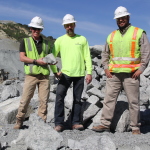Operation McDonalds
Posted by Mike Cook on Mar 31, 2015

The challenge to deliver the same product every time
If you have gone to McDonalds once, chances are you’ve been there many times. McDonalds prides itself in delivering the same flavorful experience with every visit. Whether it’s a Big Mac, McNuggets or a cup of coffee, McDonalds knows if they do it right and the same way each time, you’ll be back.
Graniterock customers are no different. They expect our rock products, concrete and asphalt to be consistent with every application. When there is a slight variation in our materials, customers notice. They are so attuned to “the way it should be” any modest change in how it behaves or performs is noticed.
Since the recipe for our products begins with the rock mining operation, the ability to deliver consistency starts at the A.R. Wilson Quarry. Right now a team of Graniterock professionals is working hard to find better ways to improve the consistency of the rock used to make our products.
Their focus is at the mining face, where the rock is taken from the mountain. This is often referred to as the primary operation, which is comprised of initial mining and primary crushing. If characteristics of the material delivered from the primary operation into the secondary processing plant are more consistent, all downstream products – base rock, concrete and asphalt - will be more consistent as well.
Nature does not make all rock equal
The rock at A.R. Wilson Quarry is more than20 million-years-old. When rock forms it has some natural variation in its constituents. Wilson Quarry rock has differing amounts of three major minerals and a number of minor minerals, so percentage changes from rock to rock create a certain amount of variation in its expected performance. When rock is formed it cools at different rates throughout the deposit. This has some impact on rock characteristics as well. These differences are significant but manageable. However, a series of environmental factors make consistency a major challenge.
Millions of years of exposure makes a difference
The rock at Wilson Quarry is constantly stressed by the San Andreas fault. Some rock is squeezed (compressed) some rock is bent (tensile force) and some rock is ground down to smaller rock (shear forces.) These forces have slightly different effects on rock properties.
With these forces also come cracks and fissures throughout the deposit that allow the material to be exposed to the outside environment. Water and air invade the rock at different concentrations bringing with them other materials like organics from above and dissolved elements and minerals from adjacent deposits beside and below. All of them act on the rock over millions of years to change it in one way or another. A major quarry challenge is to figure out how to identify and manage this natural variation better than in the past, and that research is going on right now.
Using technological advances to find a solution
Challenge: Figure out rock character near the start of processing
To characterize rock in the past, Graniterock has used big drills to remove rock cores from deep in the ground. The cores are analyzed by geologists and graded according to their properties. Results generated from various core locations are used to create maps of expected rock character for a given area so mining planners and miners had a “roadmap” to help develop the mine plan. However, because the variability within the rock deposit can be large, accuracy of the map is less than desired. Customers are demanding more precision in our products so the time has come to find a better way to characterize the material.
Space age meets 20 million-year-old rock
Current research on rock characterization is driven by technological advances from space exploration, defense-related developments and improvements to computers.
Imagine for a moment a geologist standing over a box of 2-inch diameter cores, tapping on the material with a hammer, observing its appearance and grading it. That is how rock has been assessed since Graniterock began in 1900.
At Wilson Quarry today, the primary research team is testing advanced technologies such as optical devices (picture technology), sonic devices (sound reflectance) X-rays, (mineral analysis) Infrared devices (mineral and elemental analysis) and 3-D imaging and trying to match the information generated to a particular character of the rock. These technologies also take advantage of computers to count millions of data points that would be impossible to do otherwise.
The rock may not be as tasty as a Big Mac, but the customer experience will be the same high quality every time thanks to the work under way by our quarry team, research laboratory and geology department.
Back to all Blogs
